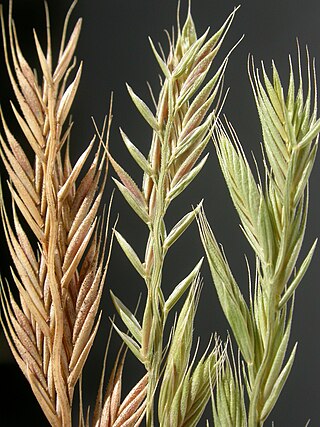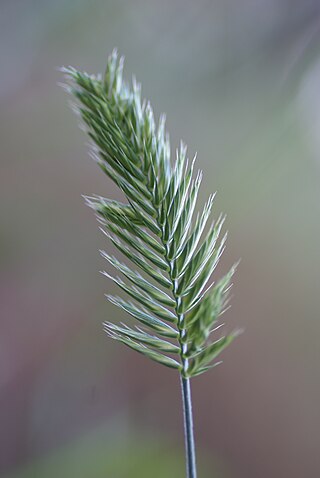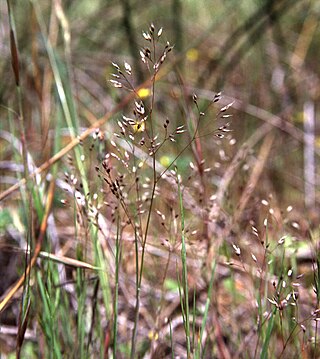
Arrhenatherum, commonly called oat-grass or button-grass, is a genus of Eurasian and North African plants in the grass family.

Dactylis is a genus of Eurasian and North African plants in the bluegrass subfamily within the grass family. Dactylis is native to North Africa, they are found throughout the world, and are an invasive species. They are known in English as cock's-foot or cocksfoot grasses, also sometimes as orchard grasses.

Festuca (fescue) is a genus of flowering plants belonging to the grass family Poaceae. They are evergreen or herbaceous perennial tufted grasses with a height range of 10–200 cm (4–79 in) and a cosmopolitan distribution, occurring on every continent except Antarctica. The genus is closely related to ryegrass (Lolium), and recent evidence from phylogenetic studies using DNA sequencing of plant mitochondrial DNA shows that the genus lacks monophyly. As a result, plant taxonomists have moved several species, including the forage grasses tall fescue and meadow fescue, from the genus Festuca into the genus Lolium, or alternatively into the segregate genus Schedonorus.

Deschampsia is a genus of plants in the grass family, commonly known as hair grass or tussock grass. The genus is widespread across many countries.

Brachypodium is a genus of plants in the grass family, widespread across much of Africa, Eurasia, and Latin America. The genus is classified in its own tribe Brachypodieae.

Cynosurus is a genus of Eurasian and North African plants in the grass family. Plants in this genus are known generally as dogstail grass. They are native to the Mediterranean Basin and neighboring regions, but some have been introduced into Australia as well as North and South America.

Vulpia is a widespread genus of plants in the grass family, native to many countries around the world and naturalized in many of the nations to which it is not native. It is most common in temperate regions.

Rostraria is a genus of plants in the grass family, native primarily to Eurasia and North Africa with one species native to South America. Hairgrass is a common name.
Coelachyrum is a genus of Asian and African plants in the grass family.

Cutandia is a genus of Asian and Mediterranean plant in the grass family. It grows from Portugal and Cape Verde to Pakistan and Kazakhstan.

Desmazeria is a genus of Mediterranean plants in the grass family, related to Catapodium.

Micropyrum is a genus of European and North African plants in the grass family.
Festuca salzmannii is a species of flowering plant in the family Poaceae (grasses), native to the Mediterranean from Spain to Cyprus, and to Turkey. It has been placed in the genus Narduroides as the sole species Narduroides salzmannii.

Diplachne is a genus of plants in the grass family, widespread over much of the world.

Sclerochloa is a genus of Eurasian and North African plants in the grass family. Hardgrass is a common name for plants in this genus.

Wangenheimia is a monotypic genus of plants in the grass family. The only known species is Wangenheimia lima.

The Poeae are the largest tribe of the grasses, with around 2,500 species in 121 genera. The tribe includes many lawn and pasture grasses.

Catapodium rigidum, ferngrass, is a species of annual grass in the family Poaceae, distributed around the Mediterranean and the Middle East. It has been widely introduced throughout drier parts of the world, including parts of North America, South America, South Africa, Korea, Australia, and New Zealand. Individuals can reach 20 cm (8 in).
















